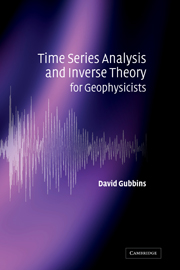Book contents
- Frontmatter
- Contents
- Preface
- Acknowledgements
- List of illustrations
- 1 Introduction
- Part I Processing
- Part II Inversion
- Part III Applications
- Appendix 1 Fourier series
- Appendix 2 The Fourier integral transform
- Appendix 3 Shannon's sampling theorem
- Appendix 4 Linear algebra
- Appendix 5 Vector spaces and the function space
- Appendix 6 Lagrange multipliers and penalty parameters
- Appendix 7 Files for the computer exercises
- References
- Index
1 - Introduction
Published online by Cambridge University Press: 05 June 2012
- Frontmatter
- Contents
- Preface
- Acknowledgements
- List of illustrations
- 1 Introduction
- Part I Processing
- Part II Inversion
- Part III Applications
- Appendix 1 Fourier series
- Appendix 2 The Fourier integral transform
- Appendix 3 Shannon's sampling theorem
- Appendix 4 Linear algebra
- Appendix 5 Vector spaces and the function space
- Appendix 6 Lagrange multipliers and penalty parameters
- Appendix 7 Files for the computer exercises
- References
- Index
Summary
The digital revolution
Recording the output from geophysical instruments has undergone four stages of development during the past century: mechanical, optical, analogue magnetic, and digital. Take the seismometer as a typical example. The principle of the basic sensor remains the same: the swing of a test mass in response to motion of its fixed pivot is monitored and converted to an estimate of the velocity of the pivot.
Inertia and damping determine the response of the sensor to different frequencies of ground motion; different mechanical devices measured different frequency ranges. Ocean waves generate a great deal of noise in the range 0.1–0.5 Hz, the microseismic noise band, and it became normal practice to install a short-period instrument to record frequencies above 0.5 Hz and a long-period instrument to record frequencies below 0.1 Hz.
Early mechanical systems used levers to amplify the motion of the mass to drive a pen. The classic short-period, high-gain design used an inverted pendulum to measure the horizontal component of motion. A large mass was required simply to overcome friction in the pen and lever system.
An optical lever reduces the friction dramatically. A light beam is directed onto a mirror, which is twisted by the response of the sensor. The reflected light beam shines onto photographic film. The sensor response deflects the light beam and the motion is recorded on film. The amplification is determined by the distance between the mirror and film.
- Type
- Chapter
- Information
- Publisher: Cambridge University PressPrint publication year: 2004



